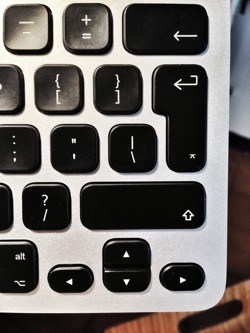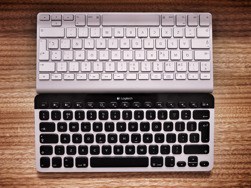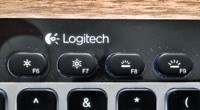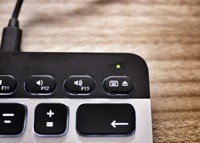Category: Keyboards
Works With: Mac, iPad, iPhone
Price: $99
This review is slightly unusual: We already published a review of the same device a couple of weeks ago: the Logitech Easy-Switch keyboard. I liked the look of it so much that — on Killian’s recommendation — I went out and bought one of my own. Or rather, I bought one, returned one and searched the internet high and low for another one.
So why the “duplicate” review? Because I use a keyboard in a different way than Killian. Where he sits at the dining room table surrounded by iDevices and Macs, I work not only in different rooms but in bars (cafes), on buses, wherever I might be. So I figured I’d write a very different review.
Interested?
Buying it
The first problem was getting one. First, the keyboard — the K811 — isn’t even listed on Logitech’s Spanish site. Second, I prefer a UK layout to the US or Spanish layouts. Let’s take a look at keyboard layout for a moment.
International Keyboard Standards
The U.S. uses the ANSI hardware standard, which has a flat return key and puts the tilde key up by the tab key.

European keyboards use the ISO standard, which has a larger, L-shaped return key and puts the tilde key down by the left shift key (the shift key shrinks to make space). I use this key a lot when typing on my iMac. Command-~ is the shortcut to reverse through the cmd-tab app switcher, and I use option-~ to bring up my clipboard history in Launchbar.
Physically, a UK-English and a Spanish keyboard are identical. You can switch the meta layout in iOS or OS X and — provided you never look at the keys — you won’t know the difference. But you can be driven crazy by seeing the parentheses shifted one key to the left (8 and 9 on the Spanish layout), but still having to hit the 9 and 0 keys to type them. And don’t get me started on the ñ.
Due to Popular Demand
I finally managed to track one down in Germany
The second problem was actually getting hold of one. The launch date in the UK (according to Amazon) was February 14th. I pre-ordered, but after the 14th arrived Amazon told me I’d been put into the back-order queue. Logitech UK was also out of stock, and as I said, Logitech Spain didn’t even acknowledge its existence.
Eventually I found one on Logitech’s German site, and I was even offered a choice of layouts. I paid my €99 ($130) plus €0 ($0) shipping and waited. But let’s not get ahead of ourselves.
The Windows Version
Before I discovered the Germans’ cache of keyboards, I was getting desperate. I’d just smashed up one of my two Apple wireless keyboards in a rage, and switching Bluetooth on and off on Macs and iPads to use one keyboard with three machines was threatening to make me blow my top again.
I was so desperate that I bought the Windows version
So desperate was I that I bought the Windows version (K810) of the keyboard in a local store. I figured that it’d be fine to use with my iPad (it’s designed for use with iOS, after all) and that my Mac could take care of changing the key layout to swap the command and option keys.
I loved it. The keys felt amazing. The keyboard was light. And it even came in a natty anodized black finish, which I still think looks better than the
silver-and-black Mac version. But there were problems.

The Windows version comes loaded with a bunch of redundant keys on the top row. Print Screen, anyone? Also, if I remember correctly, it wouldn’t change the brightness of the Mac’s screen, which is pretty annoying when there are four keys dedicated to brightness up on the top row.
I could have worked around this on the Mac, though, using Logitech’s driver software, or a third-party tweak. But then I hooked it up to my iPad.
O. M. G., as they say these days. I discovered that Windows keyboards reverse the command and option keys, even when used on an iPad. Seeing as the main use for my keyboard is editing my own badly-typed text, I use these keys all the time for making selections. And having them reversed is like having your fingers chopped off and stitched onto each other’s stumps: uncomfortable.
So I took it back to the store, tracked down the German order and waited for a few days.
Typing
The Logitech K811 is hands-down (#PunAlert) the best keyboard I have ever used. I could never get along with the big clackety keyboards like the DAS, maybe as I was so used to Apple’s MacBook and wireless keyboards.
The Logitech K811 is hands-down the best keyboard I have ever used.
But the keys on the K811 are ever-so-slightly clickier than those on the Apple Wireless, and they have a touch more travel and resistance. This makes the experience more positive (in terms of knowing you’ve hit a key). The island-style chiclet keycaps are also slightly concave, which again makes for easier typing.

And the backlight. Oh, the backlight. The Easy-Switch’s backlight is on all the time you’re typing (you can dim it down to nothing if you like), and becomes a lot like the Kindle Paperwhite’s always-on screen light. It increases contrast even in bright daylight, and is designed so that you have both the letters themselves illuminated, plus a sharply-rendered line around the edge of each key.
The backlight is so contrast-boosting that you’ll want it on all the time, even in full daylight.
The backlight also switches itself on and off automatically, waking up when your hands get near. This is another great feature that will spoil you on other keyboards. It seems to use a light meter of some kind to do the detecting, and as such can sometimes get confused. If I forget to switch it off at night, for instance, it wakes up every once in a while in my pitch-black room. This can get a little annoying.
In fact, so used to this always-on light have I become that when it died just now (somewhat coincidentally in the middle of this review, and accompanied by a breathing red LED to tell me that I was on reserve battery power), I reached for a USB battery pack immediately. You can, says Logitech, keep typing without the backlight for many more hours, but why bother when you can charge as you type.
Which brings us to…
The Hardware

The Body
The K811 is light at 338 grams (the Apple Wireless weighs in at 326 grams on my kitchen scale), and slimmer than Apple’s own. Kinda. It’s flat, so it’s slightly higher at the front edge and lower at the back.
The K811 will easily slip into cases meant for Apple’s keyboard
This means it’ll fit into cases meant for Apple’s keyboard (I have the excellent Waterfield travel case and it hold the Logitech just fine), and that it sits better on a lap. It has a plastic base, too, which is easier on bare thighs than Apple’s all-metal shell. In terms of longevity, who knows? Ask me in five years when I have been using this keyboard for as long as I used the Apple one.
Battery
Then other big difference is the battery. The K811 has a rechargeable battery (replaceable by removing a couple of screws) and a proper sliding on-off switch at the side. Apple’s uses AAs, and has that dumb long-press switch that you can never tell whether it’s off or not.

For portable use, Apple loses. I always travel with a charger or spare USB battery pack, but the only time I take a battery charger with me is if I’m taking the Apple keyboard on a multi-day trip. With the Logitech I have one less thing to carry.
Some will say that AAs are better than a rechargeable battery because you can just swap in a new pair (bought from any corner store) and keep on tying. I’d counter by saying that with the Logitech you can just plug it in and keep going, and that mains power outlets are even more ubiquitous than corner stores.
Power Switch
And the on-off switch that stays on (or off)? This will do more for your battery life than anything, and you won’t find that the keyboard has also been waking up your iPad throughout your plane journey.
Media Keys
This is where things fall down a little. Here’s what you get:
- iPad
- Home Key
- Software keyboard toggle
- Mac
- Expose
- Eject
- Screen brightness
- Both
- Volume up/down/mute
- Escape
There are also the three Bluetooth pairing keys (for switching between devices) and brightness keys for the keyboard’s own backlight (five levels, including off).
What’s missing? As Killian mentioned in his review, there’re no skip keys for media. On the Mac you can get around this with custom keyboard mappings, but not on the iPad. And seeing as these keys are not only used to skip tracks in iTunes, but also to skip through photo slideshows and Keynote presentations, it’s quite a big thing to leave out.
Also missing are brightness controls for the iPad. The keys are there on the top row, but they don’t work on the iPad. Given that the Mac brightness keys will control the iPad’s screen from most other keyboards, this is a mysterious omission. They don’t even work when you use them with the Fn key.
Bluetooth
This works great, and is the gimmick which will get most people to buy this keyboard. For me it means I need one device to type on my iPad, my iMac, and my iPad Mini, all of which I use for work. Once paired, you switch by hitting one of three dedicated keys. Switching to an iOS device is fast. The Mac takes a little longer to notice that you’re back.
The Verdict
I love this keyboard. I spend a good part of the day typing, so €99 (even cheaper at $99 in the U.S) isn’t much to pay. It’s certainly less than an amateur runner might spend on running shoes, and this keyboard should last way longer than a pair of sneakers.
Do I wish it had proper brightness keys for the iPad? Yup. And media skip keys? I guess. But these are small moans for what might be the best keyboard I have typed on. If you’re thinking about buying a keyboard case for your iPad, think twice ands consider this instead. Not only is it full size, but it is way better than even Logitech’s own iPad keyboard cases. It’s also lighter. The Zagg Pro Plus (with backlight) weighs 404 grams. This one weighs 338 grams, and a leather Smart Cover is 140 grams (even less if you’re using an iPad) mini.
I’m sold. I’m even thinking about buying another one to keep in storage for the inevitable day when I lose my rag and smash this one in, too.
 Product Name: : Easy-SwitchThe Good: Lightweight, great with iPad and Mac, replaces up to three separate keyboards, rechargeable, comfortable and accurate, smoking-hot looking. Product Name: : Easy-SwitchThe Good: Lightweight, great with iPad and Mac, replaces up to three separate keyboards, rechargeable, comfortable and accurate, smoking-hot looking.
The Bad: Weird lack of media and brightness keys. The Verdict Buy it. There’s almost no way you’ll be disappointed. Quite the opposite in fact: you’ll look forward to using it. Buy from: Logitech |
![Logitech’s Easy-Share Keyboard Is So Good, We Reviewed It Twice [Reviews] 1362753845.jpg](https://www.cultofmac.com/wp-content/uploads/2013/03/1362753845.jpg)

